The Art of Queerness: Visual Encodings of Non-normative Gender in Cyberpunk Comics
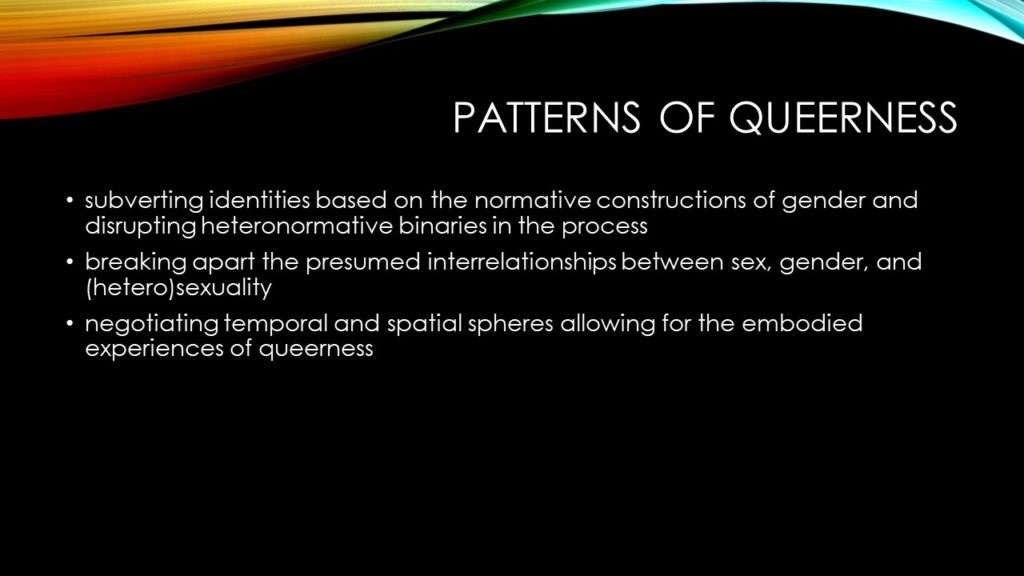
Similarly to queerness itself identified by Darieck Scott and Ramzi Fawaz in the context of comics as a ‘a social force, a complex network of erotic and affective ties, or an entire shared culture’[1] and queer theory used to conceptualize and research it, since their very beginnings comics as a medium, as cultural texts, and as a culture have been breaking down the sociocultural binaries, exploring non-normative expressions of sexualities and gender, visualizing spaces of dissonances and fluid understandings, and defying normative ties, temporalities, and experiences. In Fawaz’s words, they remain ‘malleable or generous enough to function as a vehicle for expressing varied conceptions of queerness’[2].

Comics focusing on queer explorations of historically heterosexual and masculine cyberpunk spaces often use the visual sides of the narrative to emphasize queer elements and bring out new meanings. The virtual realities of characters can be interspersed with phantasmagorical visions and graphic experiments. The latter are used mainly in the scenes presenting visions of virtual technologies and non-human bodies where visual narration is brought to the foreground which enables departure from common plot patterns and forces the reader to recalibrate and focus on the visual signifiers. On some pages, frames and gutter can be invisible or blurred in a way that disrupts the sequence or builds up anticipation without a clear narrative reasons to do so. Moreover, the psychedelic colours denormalize what should be hegemonic and radically subvert representations. All that results in a sense of a queer, flexible, or illogical temporalities and leads to the multiple readings of the same page or panel as the readers cannot use their conventional knowledge of causality to fill in the gaps hermeneutically. These are spaces of intense protection against those who are not open to difference and diversity even on the formal level.
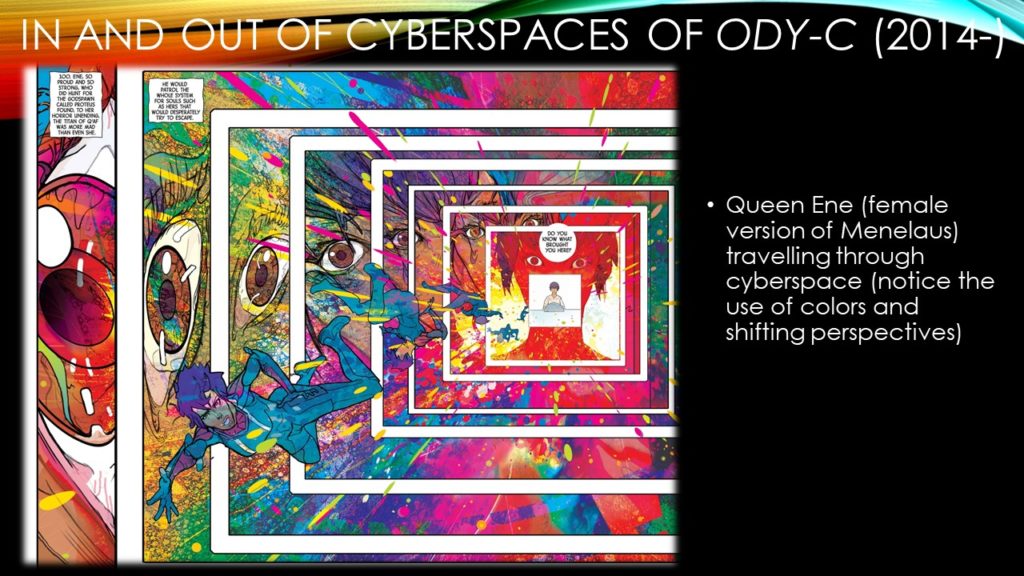
Matt Fraction and Christian Ward’s ODY-C (launched in 2014) is a multi-layered speculative re-imagination of Homer’s Odyssey centred around the events from the epic poem and extended by the introduction of myths that are only loosely related to the fall of Troy and Greek mythology as well as characters known from the Middle Eastern folk tales. The literary source was not only adapted to another medium: it underwent substantial changes as the genre was also transformed: myth that is usually associated with fantasy stories is presented here in the science fiction convention. Odysseus is a captain of a space ship and is sailing across the galaxy using a complex network of cyberspaces.
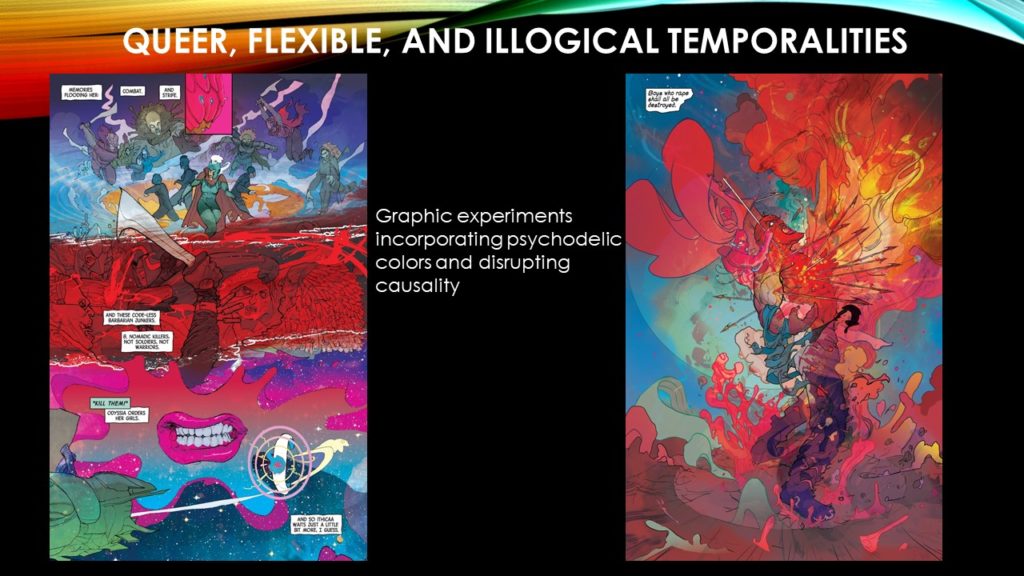
These changes, however, are pushed into the background when the reader at the very beginning of the series learns that it is not king Odysseus but queen Odyssia returning home after the Trojan War that started with a conflict over the first man born in thousands years. His name, He, can be read as a play on ‘Helen’ or an attempt to show him as nameless and limited to the (male) gender. Second issue explains that in the universe of ODY-C, men were destroyed by Zeus, the all-mother, ‘who murdered her father in violent spite, on his bloody throne, from which he created all things’[3]. Afraid of similar fate, Zeus wanted to make sure that there would be no future generations. Her plans were foiled by Promethene who evaded the no-men law by creating a unique gender, ‘sebex’, seemingly capable of giving birth to only women and other sebex. Thus, ODY-C focuses readers’ attention on the complete disruption of the interrelationship between sex and gender by presenting men known from myths as women inhabiting the spaces of cyberpunk and science fiction.
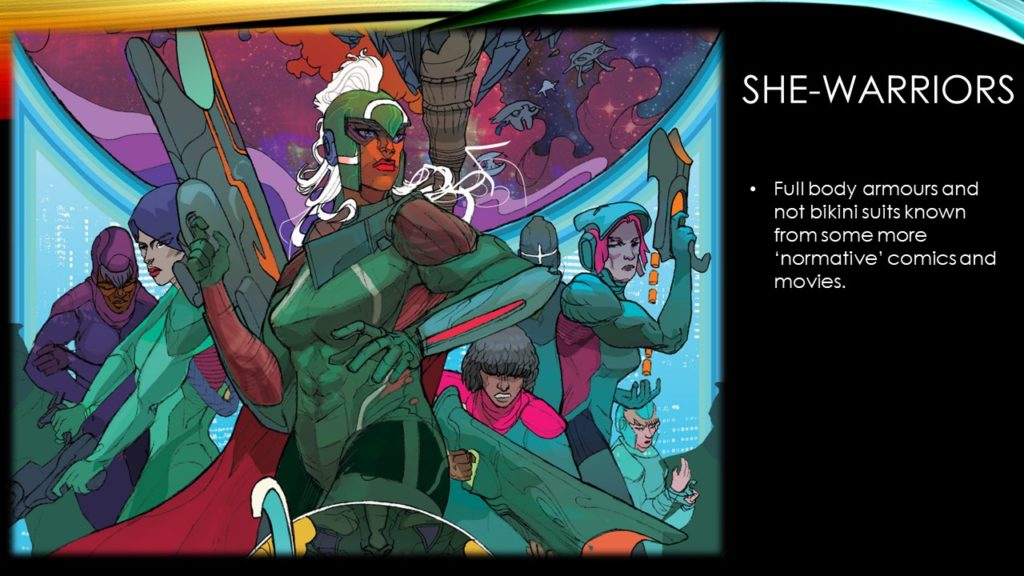
She-warriors of ODY-C are in their prime, donning full body armours. Their facial expressions and body language suggest that they are always ready for fight. Many of the features that the authors gave them are stereotypically considered to be inherent signifiers of manhood: ‘they are aggressive, assertive, independent, competitive, insensitive’[4]. In the world deprived of men, they took over their place in the hierarchy of power (former place of women was given to the sebex who are capable of reproduction). Thus, by altering the gendered fabric of the society, the authors are able to comment not only on lived realities but also on the discourses of knowledge and power that shape these realities.
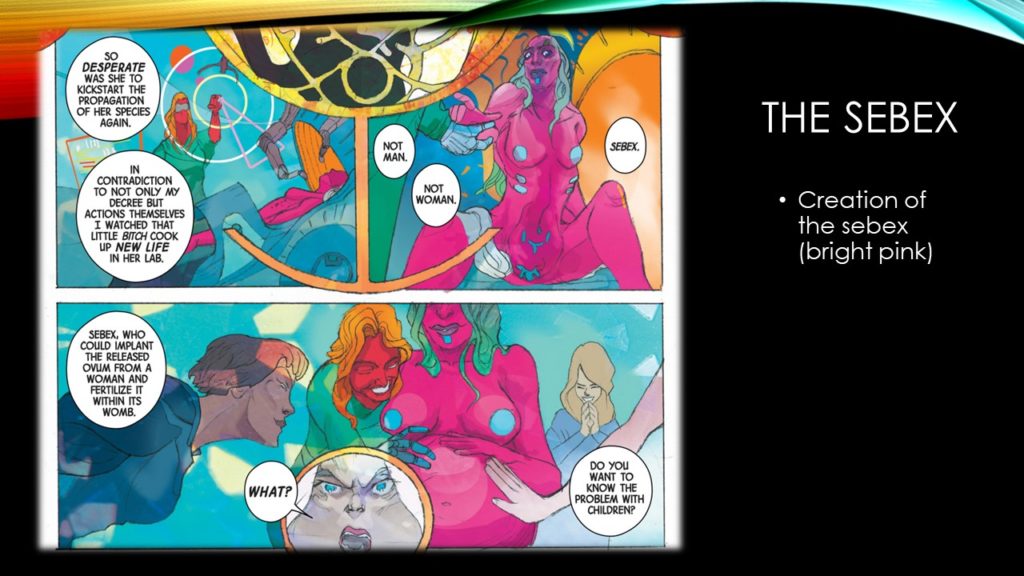
The aforementioned sebex are people who in the comics allowed for the shift in gender norms that led to the change in the meaning of what was considered valued and valuable body in the new world. At the same time they are also people on the bottom of the social ladder that favours not male hegemony but female hegemony. Binary opposition is preserved, only the oppressed group changes (though not completely): the most valued are still relationships in which the binarity is expressed in woman-sebex couples. The sebex are drawn almost always in bed and/or in a state or undress, with long hair and rosy skin. Some have heavy tribal makeup. This emphasizes their position in the social hierarchy of race, gender, and class and situates them as the Others subordinated to the dominant heterosexist desire. They not only took former place of women in the sexist society but also exist as the visual and narrative signifiers of queerness that embrace fluidity, challenge categories and resist static categorizations. While they seem to be of no real consequence to the storylines, they are an important part of the world-building of ODY-C as they queer and transform all the erotic acts and expressions of intimacy.
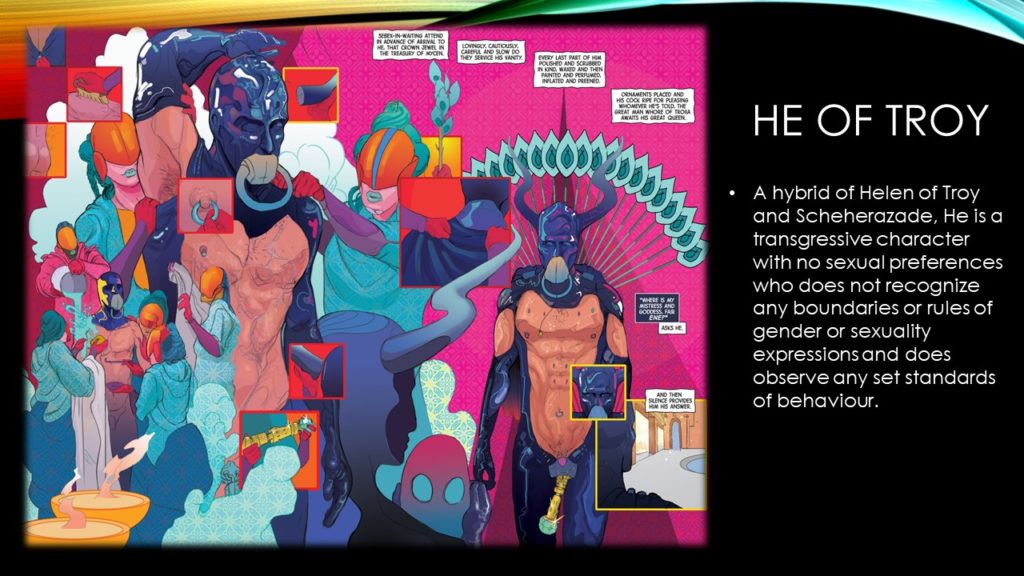
An individual character who clashes the most with the heterosexist gender norms is, paradoxically, a man: He of Troy. Enslaved by queen Ene after the Trojan War, he is granted freedom on Q’af, world ruled by men. He is never shown as trying to assimilate and ‘pass’ as a hypermasculine male in accordance with the standards of the society he exists in. He is not interested in the normalized gender status: neither his outfit nor his habits change. His is a different way of doing queerness: not just visual but also visible in terms of the incorporated self-reflexivity and self-discovery as well as being open to new experiments, new events, new futures. Narratively, he exists both inside and outside the queer/heteronormative ideologies which only serves to further the fluidity of his queer identity and disrupt the practices and assumptions that are perceived as normal.
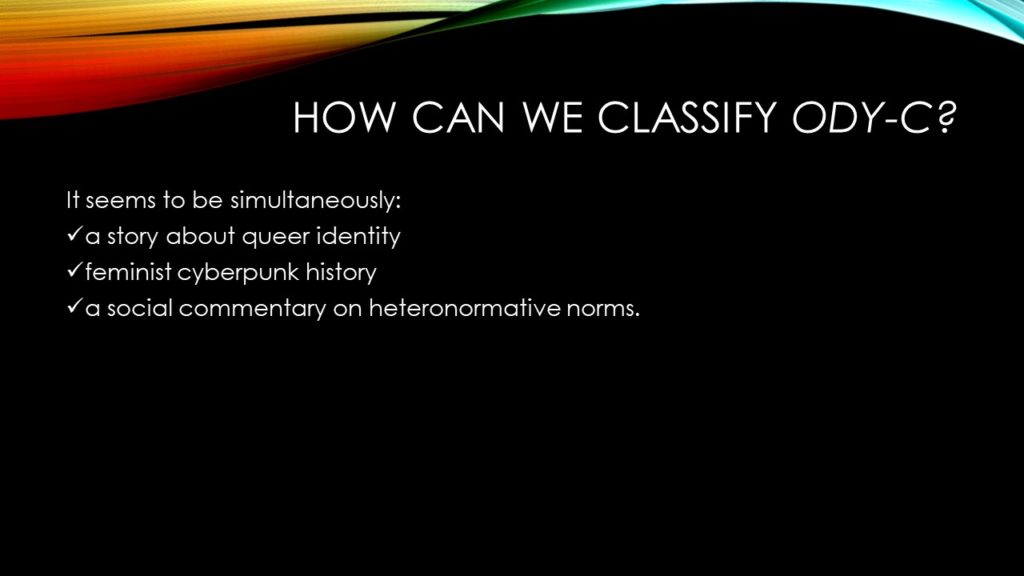
In conclusion, ODY-C takes a strange place among the feminist LGBTQ+ comics. In fact, the entire second volume of the series is a full of allusions, quotes, and references to the so-called rape culture framed by the repeated line: ‘Boys who rape shall all be destroyed’[5]. The series deconstructs the notions of natural and normal bodies and sexualities by establishing a universe the laws of which reject normative social orders as well as hegemonic classifications and then re/appropriating them within a universalising discourse. Thus, the introduction of the third gender, seemingly leading to freeing humanity from Zeus’ curse and, more importantly, women from the rules of men, results in the reorganization of patriarchy and intensification of binary division of gender norms. In other words, the conventionality of the categories of gender and sexuality is both emphasized and invalidated and queer performativity is framed by the heteronormative hegemony. The disruption of social norms caused by the extermination of men and creation of sebex leads to the reconstruction of power relations and, yet again, favouring conventional ideologies which results in the attempts at subjugating those who can be seen as queer.
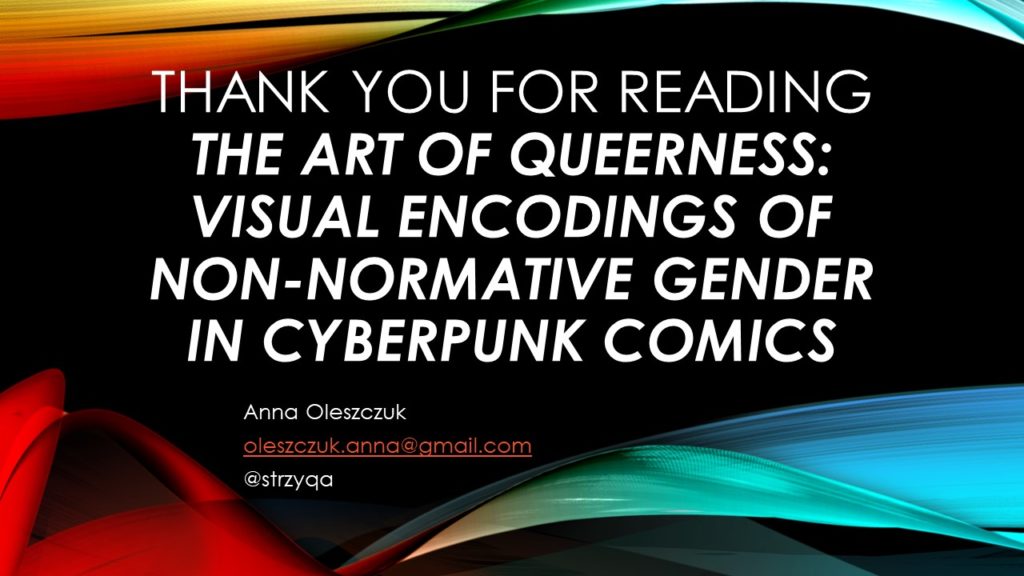
References
- Brittan, Arthur, Masculinity and Power (Oxford, UK: John Wiley & Sons, 1991)
- Fawaz, Ramzi, ‘Stripped to the Bone: Sequencing Queerness in the Comic Strip Work of Joe Brainard and David Wojnarowicz’, ASAP/Journal, 2.2 (2017), 335–67
- Fraction, Matt, and Christian Ward, Off to Far Ithicaa, ODY-C (Berkeley, CA: Image Comics, 2015), i
- ———, Sons of the Wolf, ODY-C (Berkeley, CA: Image Comics, 2016), ii
- Scott, Darieck, and Ramzi Fawaz, ‘Introduction: Queer about Comics’, American Literature, 90.2 (2018), 197–219
[1] Darieck Scott and Ramzi Fawaz, ‘Introduction: Queer about Comics’, American Literature, 90.2 (2018), 197–219 (p. 200).
[2] Ramzi Fawaz, ‘Stripped to the Bone: Sequencing Queerness in the Comic Strip Work of Joe Brainard and David Wojnarowicz’, ASAP/Journal, 2.2 (2017), 335–67 (p. 361).
[3] Matt Fraction and Christian Ward, Off to Far Ithicaa, ODY-C (Berkeley, CA: Image Comics, 2015), i.
[4] Arthur Brittan, Masculinity and Power (Oxford, UK: John Wiley & Sons, 1991), p. 4.
[5] Matt Fraction and Christian Ward, Sons of the Wolf, ODY-C (Berkeley, CA: Image Comics, 2016), ii.
Discord Discussion
This discussion has been copied from the Discord server, names have been reduced to first name, discussion threads have been grouped and edited for better readability.
